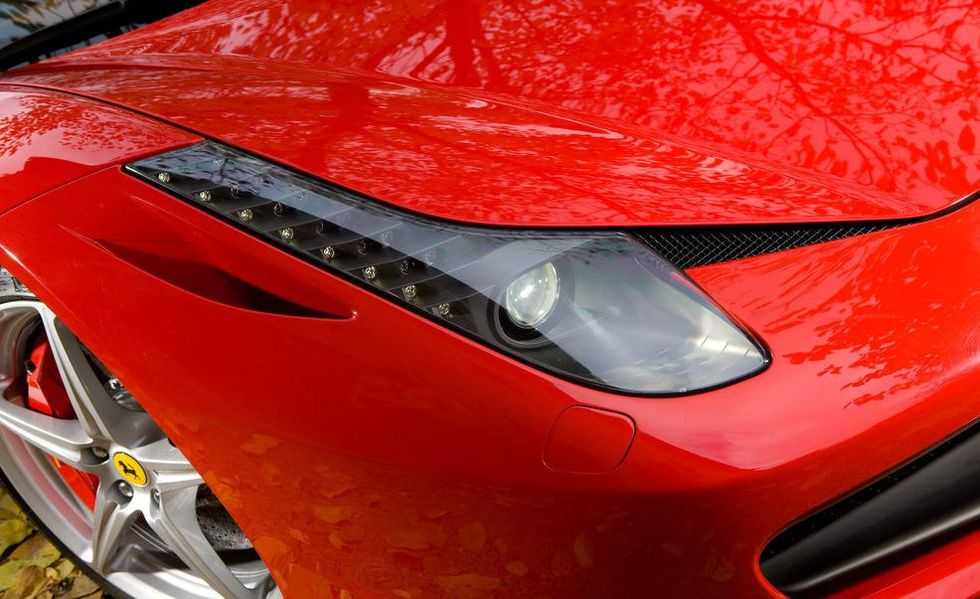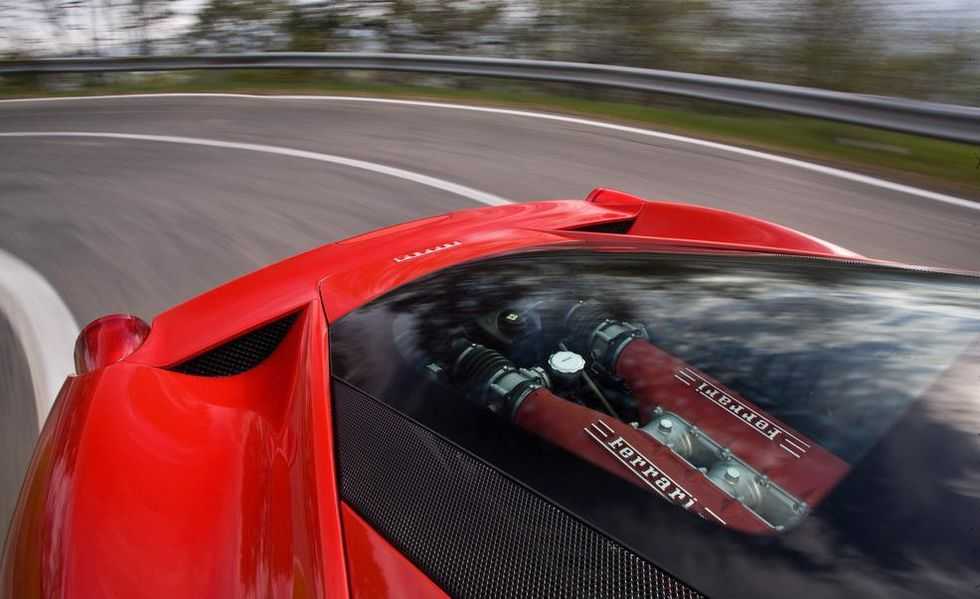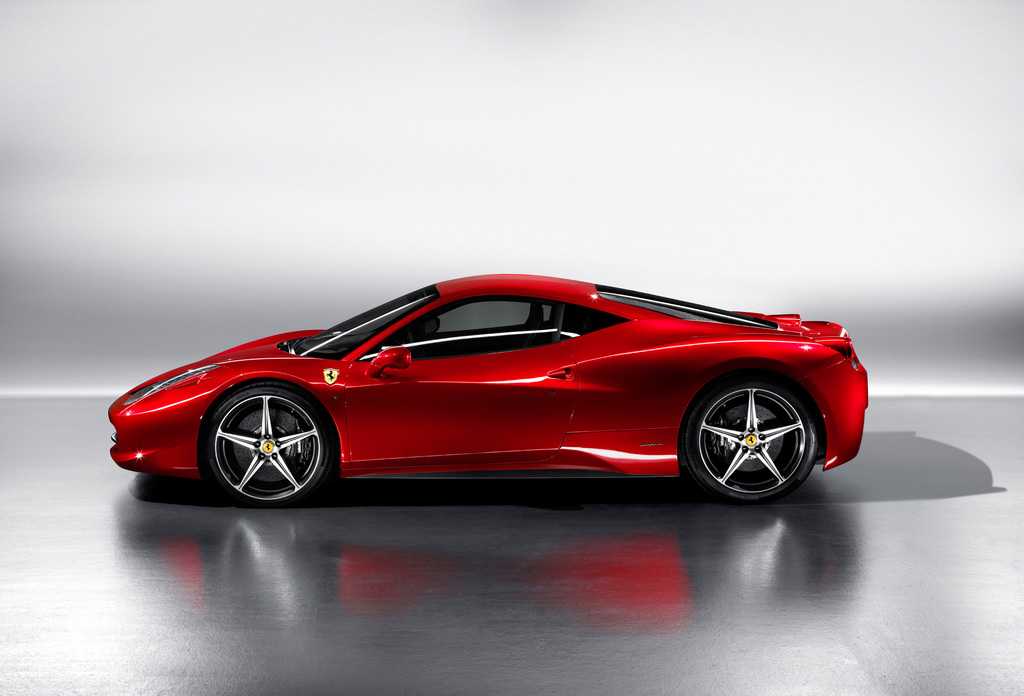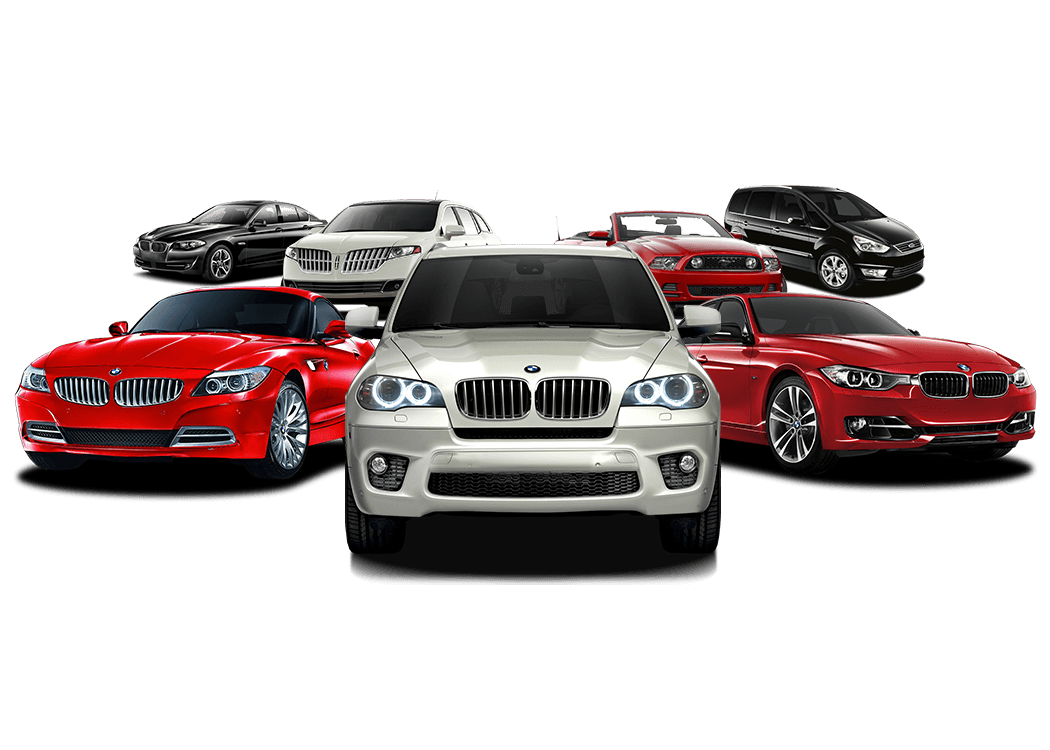Driving Impressions
Electronic magnetorheological shock absorbers keep the car’s body flat and calm, even over the heart-fluttering yump! on Fiorano’s bridge. Traction and stability control, the electronic differential, and a sport ABS mode—all adjustable via the steering wheel’s “manettino” (it means “little handle”)—do for grip on braking and corner exits what they would do in Formula 1 were they not banned. Unless the traction and anti-spin devices are switched off or set to the low-intervention mode, the Italia churns out of corners as if Jupiter himself is sitting on the back bumper.
The Ferrari touchstones are all there: the fishbowl engine hatch, the shapely pair of thighs in red spandex underneath, and an interior swaddled in perfumed leather. The saucy yellow tach carries over, as do the transmission and launch-control buttons, which look like three shotgun shells embedded in the center console.
But Ferrari’s mid-engined car has been reshaped, the cockpit bubble pushed forward to mimic an F-16’s canopy silhouette. The wheelbase grows by almost two inches, and the overhangs shrink. The F430’s flaring nostrils are gone, replaced by a single carp’s mouth split by deformable airfoils .
 View PhotosCHARLIE MAGEE|Car and Driver
View PhotosCHARLIE MAGEE|Car and Driver
Other changes: The 4.5-liter engine speaks with a deeper voice than the old 4.3. It’s less of a shriek than a manly bellow. Compared with the hand-fabricated simplicity of prior Ferrari dashboards, the 458’s is a garden of abstract sculpture. Fingers need time to acclimate to the crowded steering wheel with its buttons for turn indicators, high-beams, and wiper controls. Knobs page through a pair of digital display screens in the cluster. To the right of the tach: navigation, radio, or a digital facsimile of an analog speedometer. To the left is car status, including a hokey “Vehicle Dynamic Assistance” screen. The engine/gearbox, brake, and tire temperatures are predicted—it’s all done mathematically rather than with sensors—in three colors. Blue is for “warm-up,” green is “go,” and red means it’s “over,” as in “game over.”
It was Ferrari chairman Luca di Montezemolo’s idea to name the new car after Ferrari’s homeland, and the 458 recalls bygone days when Ferraris were numbered by engine displacement in liters plus cylinder count (e.g.: the 1976–’84 512 Berlinetta Boxer). Overtones of Donkey Kong notwithstanding, the 458 should keep Ferrari on top as the producer of the world’s most stimulating noisemakers.
 View PhotosCHARLIE MAGEE|Car and Driver
View PhotosCHARLIE MAGEE|Car and Driver
Eight Under Glass
Ferrari calls the 458’s 4.5-liter, dry-sump, flat-plane-crank V-8 the F136FB, part of the family that includes the F136I in the California model and the F136E in the outgoing F430. All share bore centers and block basics, though only with the FB does Ferrari claim a world record for specific output in a nonturbo production engine: 125 horsepower and 89 pound-feet of torque per liter. Three developments were vital: direct fuel injection, friction reduction, and better breathing. The 2900-psi injection system and shell-shaped piston crowns tailor the injection charge to be rich at the plug and lean elsewhere, cooling down combustion temperatures and allowing the lofty, 12.5:1 compression ratio that better harnesses the fuel’s energy. Piston skirts receive a graphite coating to reduce friction, and tappets get a slippery DLC, or “diamond-like carbon,” coating developed for F1 engines. Deep in the block, pumping losses are stemmed by employing three electric scavenge pumps, one for the inner-four piston bays and one each for the outer four. These pumps both return the oil to the reservoir and also better equalize the air pressure between the bays to reduce pumping losses due to “windage,” or air movement inside the block caused by piston motion. Ferrari says windage losses in the old F136E knocked almost seven pound-feet off its torque output.
Arrow pointing downArrow pointing down
Specifications
SPECIFICATIONS
2010 Ferrari 458 ItaliaVehicle Type: mid-engine, rear-wheel-drive, 2-passenger, 2-door coupe
ESTIMATED BASE PRICE$226,000
ENGINE TYPEDOHC 32-valve V-8, aluminum block and heads, direct fuel injectionDisplacement: 274 in3, 4497 cm3Power: 562 bhp @ 9000 rpmTorque: 398 lb-ft @ 6000 rpm
TRANSMISSION7-speed dual-clutch automated manual
DIMENSIONSWheelbase: 104.3 in Length: 178.2 inWidth: 76.3 in Height: 47.8 inCurb weight: 3450 lb
PERFORMANCE (C/D EST)
Zero to 60 mph: 3.3 sec
Zero to 100 mph: 7.4 sec
Standing ¼-mile: 11.5 sec @ 128 mph
Top speed (drag limited): 202 mph
PROJECTED FUEL ECONOMY (C/D EST)
EPA city/highway driving: 12/17 mpg
Характеристики
Двигатель
4,5-литровый V8 от модели 2011 года
На выставке Парижского автосалона 2012 г.
Внутренний вид 458 Italia
Он оснащен безнаддувным двигателем V8 объемом 4497 см³ (4,5 литра) с очень легкими внутренними элементами и крошечными юбками поршня , что обеспечивает низкую инерцию вращения и степень сжатия 12,5: 1, обеспечивая максимальную мощность 570 л.с. (562 л.с., 419 кВт). ) при 9000 об/мин , что на 500 об/мин выше, чем у F430, и обеспечивает максимальный крутящий момент 540 Н·м (398 фунт-фут) при 6000 об/мин, причем 80 % того же значения доступно при 3250 об/мин.
Он включает в себя непосредственный впрыск топлива впервые в Ferrari со средней конфигурацией двигателя. Система смазки с сухим картером . ]
Трансмиссия
Двигатель соединен с 7-ступенчатой коробкой передач с двойным сцеплением Getrag типа F1 , аналогичной той, что используется в Ferrari California, которая может работать в ручном или автоматическом режиме, которая была модифицирована с различными передаточными числами, позволяющими переключаться быстрее, чем за 0,06 секунды. 430 Скудерия. ]
Подвеска и рама
Подвеска двухрычажная спереди и многорычажная сзади, наряду с электронным дифференциалом и системой контроля тяги Формулы-1 , также известной как F1-Trac , которые контролировались самим ЭБУ и предназначены для улучшения поведения на поворотах и продольного ускорения . на 32% по сравнению с предыдущими версиями.
Клееное , а не сварное шасси было разработано американским заводом Alcoa, третьим по величине производителем алюминия в мире, с сухим весом 1380 кг (3042 фунта) с использованием некоторых сплавов , которые используются в аэрокосмическая промышленность . Кроме того, инженеры добились оптимальной развесовки : 58% приходится на заднюю ось , а остальные — на переднюю. ]
Тормоза
Он оснащен 398 x 36 мм (15,7 x 1,4 дюйма) Brembo с карбон — керамическими вентилируемыми дисками и шестипоршневыми алюминиевыми суппортами спереди.
Если вы едете со скоростью 100 км/ч (62 мили в час), он полностью останавливается через 40 м (131 фут). Это вместе с ABS сократило тормозной путь 458 Italia со 100 до 0 км / ч (от 62 до 0 миль в час) на 32,5 м (107 футов). ]
Производительность
Официальное ускорение от 0 до 100 км/ч (от 0 до 62 миль/ч) составляет 3,4 секунды, а максимальная скорость составляет 325 км/ч (202 мили/ч) при расходе топлива в смешанном цикле 13,7 л/100 км (7,3 км/л; 17,2). миль на галлон). Непосредственный впрыск также помог сократить выбросы CO 2 , производя 320 г (11,3 унции) / км, хотя он быстрее и производит значительно больше мощности, чем F430 или 430 Scuderia. 458-й проехал трассу Фьорано за 1 минуту 25 секунд, что намного меньше, чем у Ferrari Enzo. ]
| Варианты: | 458 Италия | 458 Паук ] | 458 Специале ] |
|---|---|---|---|
| Кормление | Прямой впрыск, без наддува. | ||
| Распределение | Двойная (DOHC) головка для каждого ряда цилиндров и 4 клапана на цилиндр (всего 32), с VVT . | ||
| Отверстие x ход | 94 х 81 мм (3,70 х 3,19 дюйма) | ||
| Емкость топливного бака | 95 литров (25,1 галлона). | 86 литров (22,7 галлона). | |
| степень сжатия | 12,5:1. | 14,0:1. | |
| максимальная мощность | 570 л.с. (562 л.с., 419 кВт) при 9000 об/мин. | 605 л.с. (597 л.с., 445 кВт) при 9000 об/мин. | |
| максимальный крутящий момент | 540 Н·м (398 фунт-футов) при 6000 об/мин. | ||
| Выбросы CO2 | 320 г (11,3 унции)/км. | 275 г (9,7 унции)/км. | 277 г (9,8 унции)/км. |
| сухой вес | 1380 кг (3042 фунта). | 1430 кг (3153 фунта). | 1290 кг (2844 фунта). |
| Максимальная скорость | 325 км/ч (202 мили в час) | 320 км/ч (199 миль в час) | 325 км/ч (202 мили в час) |
| Ускорение | |||
| от 0 до 100 км/ч (62 мили в час) | 3,4 секунды. | 3 секунды. | |
| от 0 до 200 км/ч (124 миль/ч) | 10,4 секунды. | 10,8 секунды. | 9,1 секунды. |
| 1/4 мили (402 м) | 11,3 секунды. | 11,4 секунды. | 10,7 секунды. |
| от 0 до 1 км (0,62 мили) | 20,3 секунды. | 20,5 секунд. | 19,4 секунды. |
| 1-й | 2-й | 3-й | 4-й | 5-й | 6-й | 7-й | Финал |
|---|---|---|---|---|---|---|---|
| 3.08 | 2.19 | 1,63 | 1,29 | 1,03 | 0,84 | 0,69 | 5.14 |
Chassis & Handling
Much like the engine, aluminum is the name of the game when it comes to the chassis design. Combined with aerospace-grade alloys and an advanced heat-forming process, the modular chassis is lighter and has more structural rigidity than ever before – up 15 percent over that of the Ferrari F430.
This provides a platform which really augments the 458’s new double wishbone and multi-link suspension setup in the front and rear, respectively. Overall, this configuration significantly minimizes body roll while improving steering response and feedback, without any notable penalty to ride quality.
The Magnetorheological Suspension Control system is state of the art. It actively manages damper forces and bump control to promote smoothness and ride comfort, while reducing component friction; ultimately, making the car easier and more enjoyable to drive in any situation.
The synergy of E-Diff and F1-Trac systems results in a 32 percent increase in longitudinal acceleration out of corners compared to previous models. This is the result of an advanced ECU which processes faster and more accurate calculations of grip levels, subsequently improving handling and ease of control at the limit.
With regards to the standard carbon ceramic brake setup, the same ECU also governs the 458’s high-performance ABS system, providing enhanced precision and greater efficiency in caliper movement and brake pad contact. Braking distance from 100 km/h to a complete stop, has been reduced to just 32.5 m as a result.

Design, Styling & Interior
Most aspects of the 458’s design are driven primarily by the goal of maximizing aerodynamic efficiency, with each element working in concert with the other. At the front bumper, aeroelastic winglets bend at speed to increase airflow under the car and towards the rear, where a diffuser resides.This harmony of functionality can produce up to 794 lbs of downforce, split 41/59% over the front and rear wheels respectively.
Air apertures in the C-pillar direct air towards the engine and vents above the rear diffuser, which also assist in cooling the transmission and radiators. The final element is a small intake and exit located near the front headlights, which helps to reduce drag.
Ultimately, the 458 has remained one of the finest executions of functionality and form to this day. Its styling cues are decidedly Pininfarina, yet also a complete evolution from the classic Ferrari silhouette at the same time. Perfectly proportioned, timelessly elegant and deliberately streamlined; the Ferrari 458 Italia is the perfect consensus of minimalism, efficiency and capability.
Inside the cabin, you can expect the same marriage of simplicity and sporty personality. The cockpit reflects an intuitively functional layout and thoughtfully ergonomic design. Exposed aluminum panels and trim pieces are a nod to the car’s racing DNA, contrasting the signature use of high quality Italian leather throughout.
The piece that truly brings everything together is the steering wheel. With mounted features such as the Manettino switch, Engine Start, indicator buttons, and shift paddles, drivers have charge of a command center at their fingertips. Convenience features such as infotainment, navigation and a back-up camera, are also available for the car.
Ferrari 458 Pricing
Price When New
Back when it was first released for the 2010 model year, the Ferrari 458 Italia had a base price of US$225,000. Options would add another $25,000 or so, with more bespoke appointments raising costs even further.
Subsequent models and trims such as the Spider, Speciale and Challenge commanded varying degrees of premium over the original car. As this article focuses on the latter, we’ve also done an analysis on what the used market currently looks like for the 2010 car.
Current Used Market
Quickly glancing at the (US) pre-owned market, it appears that a used 2010 Ferrari 458 Italia tends to command around $150,000 on average. Examples are typically lower mileage as you would expect, rarely having more than 15,000 clicks on the odometer.
Newer models (2012+) seem to command a premium over the earlier models, so jumping up to a later version can increase the price at least $50,000. This is due to the higher likelihood of transmission problems documented in 2010-2011 examples, which appears to have been smoothed over in the following model years.
Specifically for 2010 models, there have been rare instances of engine fires caused by the application of improper adhesives in the rear wheel arches – this issue prompted a manufacturer recall. If you are in the market for a pre-owned Ferrari 458 Italia – particularly an early model – ensure you’ve done your due diligence with regards to this recall or anything related to the transmission. The 458 otherwise has a lengthy and solid reputation of being a reliable car.
[править] Гонки
Теперь основным автомобилем монокубке «Ferrari Challenge», является именно Ferrari 458 Challenge. В европейской серии, Ferrari Challenge Europa, принимает участие украинская команда, Ferrari Team Ukraine, которая занимает высокие результаты.
458 Italia GT2
Ferrari представила свой новый гоночный 458 GT2 в 2011 году. Ferrari 458 GT2 комплектуется 4.5L двигателем мощностью 470 л.с. (346 кВт), что меньше, чем в дорожной версии и 458 Challenge. В отличие от дорожного автомобиля, который имеет высокие оборты двигателя, версия GT2 развиваю обороты только до 6250 оборотов в минуту, но сохраняет близкие к базовой модели крутящий момент. . Ferrari 458 GT2 участвует в американской серии Ле-Ман, FIA World Endurance Championship и европейской серии Ле-Ман.
458 Italia GT3
Ferrari представила также версия Ferrari 458 Italia GT3 в 2011 году. Автомобиль полегче и мощнее, чем версия GT2, мощность двигателя составляет 550 л.с., а красная зона составляет 9000 оборотов в минуту. Аэродинамика автомобиля также несколько отличаются из-за разных авиационные правила. 458 Italia GT3 участвует в многочисленных гоночных сериях, включая FIA GT3 European Championship, FIA GT1 World Championship, Blancpain Endurance Series, International GT Open, а также других многочисленных национальных чемпионатах GT3.
458 Italia Grand-Am
В 2012 году Ferrari разработала модифицированную версии 458 GT3 для Grand-Am. Автомобиль весит столько же, но производит меньше прижимной силы, чем автомобиль GT3, двигатель также мощностью 500 л.с. (373 кВт), с красной зоной 8000 оборотов в хвилину.Замисть последовательной коробкой передач, автомобиль оборудован традиционной механической коробкой передач. Каркас также изменен через строгие правила техники безопасности. Grand-Am версии не хватает контроля тяги и ABS. Автомобиль дебютировал в 2012 во время 24 часа Дайтона.
Вы узнали технические характеристики Ferrari 458 Italia, но есть не менее интересные автомобили:
- BMW X5
- Cadillac SRX
- Dodge Viper
Engine & Performance
- Engine Type & Size: 4.5L naturally-aspirated V8
- Horsepower: 562 hp @ 9,000 rpm
- Torque: 398 lb-ft @ 6,000 rpm
- Transmission: 7-speed dual-clutch
- 0-60 mph: 3.2 seconds
- Top Speed: 202 mph
Before getting down to the nitty-gritty of the 458 Italia’s performance specifications, let’s just mention that its F136-FB V8 engine provides one of the most thrilling soundtracks produced by any road-going vehicle out there, courtesy an orchestra which octaves all the way to 9,000 rpm. Bellissima!
Compared to its predecessor, the 458’s all-aluminum power plant provides the best of all worlds – it’s more powerful, more durable and more fuel efficient in spite of a 0.2L displacement premium. This is in part due to some variable valve wizardry, with three pneumatic throttle valves regulating air flow at the intake and exhaust. Surprisingly, it is also the first Ferrari mid-engine road-car to feature direct fuel injection.
The 458 comes exclusively with a 7-speed dual-clutch Getrag transmission which can change gears in as little as 0.04 seconds. Electronic nannies also help tether the car’s performance in relation to driving conditions and preferences, with a steering-wheel-mounted Manettino switch allowing the driver easy access to a number of preset driving modes on the fly. Each mode – which includes: Wet, Sport, Race, CT Off and ESC Off – delivers varying levels of involvement from the E-Diff, traction control, stability control, ABS, active suspension and transmission systems.































